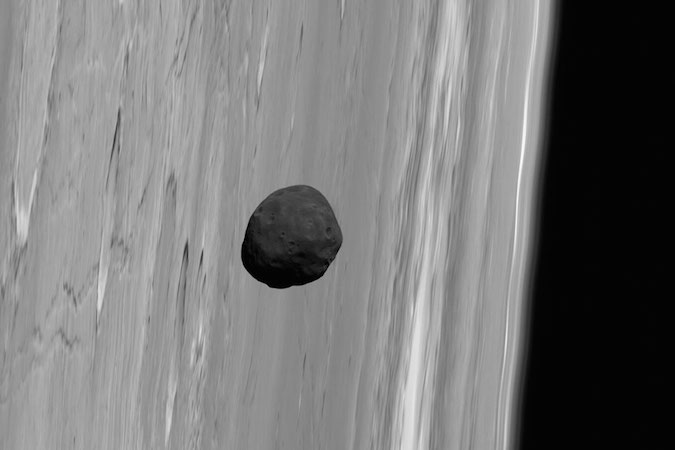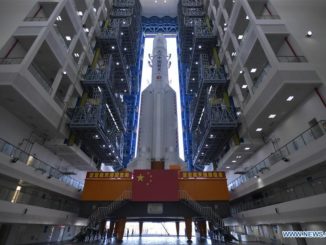
NASA announced Thursday it will fund development of a scientific instrument that will fly on Japan’s Martian Moons Exploration mission, a robotic probe set for launch in 2024 to bring back the first samples from Mars’ largest moon Phobos.
A neutron and gamma-ray spectrograph developed by a team led by David Lawrence of the Johns Hopkins University Applied Physics Laboratory in Laurel, Maryland, will help officials decide where the Japanese spacecraft will pick up samples on Phobos.
Fitted with a souped-up propulsion module, landing legs and a sample carrier, the spacecraft will enter orbit around Mars, then rendezvous with Phobos before landing on the moon to core into its surface and gather rock fragments. The craft will take off from Phobos — an asteroid-like object with weak gravity — and make several flybys of the smaller moon Deimos before firing its engines to head back to Earth, arriving home in mid-2029.
The ambitious mission, known as MMX, will follow Japan’s Hayabusa and Hayabusa 2 asteroid sample return projects. Hayabusa brought microscopic asteroid specimens back to Earth in 2010, and Hayabusa 2 is set to arrive at its target — asteroid Ryugu — next year to collect samples for return to Earth in 2020.
MMX is the first of three “strategic” space missions planned by the Japan Aerospace Exploration Agency in the 2020s. Two astronomy missions, named LiteBIRD and SPICA, could follow later in the decade.
JAXA’s strategic missions are expected to cost approximately $300 million, not including international contributions.
The planned Phobos sample return mission aims to return the first material directly from the surface of Phobos.
A Russian mission named Phobos-Grunt launched in 2011 had the same objective, but a rocket mishap stranded the probe in orbit around the Earth before it could depart for the red planet. Russian scientists have developed plans for another Phobos mission, but the project has not been formally approved, and if given the go-ahead would likely launch after MMX.
The NASA-funded instrument — named MEGANE, meaning “eyeglasses in Japanese — will measure the elemental composition of Phobos by detecting neutrons and gamma-rays emitted from the small moon, scientists said.
A major science goal of the MMX mission is to determine the origin of the Martian moons. Theories suggest Phobos and Deimos were either asteroids captured by Martian gravity, or they coalesced from rocky debris generated from an ancient impact on Mars.
Phobos has an average diameter of about 14 miles, or 22 kilometers.

“Solving the riddle of how Mars’ moons came to be will help us better understand how planets formed around our Sun and, in turn, around other stars,” said Thomas Zurbuchen, associate administrator for NASA’s science mission directorate. “International partnerships like this provide high-quality science with high-impact return.”
“We’ll see the composition of the region from which MMX collects its sample,” said Thomas Statler, program scientist for MMX at NASA Headquarters in Washington. “This will help us better understand what we discover in the laboratory when the mission returns the sample to Earth for analysis.”
NASA selected the MEGANE instrument from proposals submitted by multiple U.S. science teams. Managed under NASA’s Discovery program as a mission of opportunity, the MEGANE instrument has a cost cap of $15 million.
JAXA and the French space agency CNES announced in April their partnership on the MMX mission.
French scientists committed to build an infrared camera and spectrometer named MacrOmega to fly on the MMX spacecraft. Like MEGANE, the CNES-provided instrument will help scientists locate the best place to collect a sample.
French engineers will also study the possibility of adding a miniature rover to the MMX mission, and provide flight dynamics and navigation expertise to the Japanese team.
Email the author.
Follow Stephen Clark on Twitter: @StephenClark1.



